
The United States Department of Veterans Affairs (VA) is a Cabinet-level executive branch department of the federal government charged with providing lifelong healthcare services to eligible military veterans at the 170 VA medical centers and outpatient clinics located throughout the country. Non-healthcare benefits include disability compensation, vocational rehabilitation, education assistance, home loans, and life insurance. The VA also provides burial and memorial benefits to eligible veterans and family members at 135 national cemeteries.
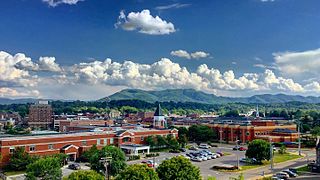
Johnson City is a city in Washington, Carter, and Sullivan counties in the U.S. state of Tennessee, mostly in Washington County. As of the 2020 United States census, the population was 71,046, making it the eighth-most populous city in Tennessee. Johnson City is the principal city of the Johnson City Metropolitan Statistical Area, which consists of Carter, Unicoi, and Washington counties and had a population of 207,285 as of 2020. The MSA is also a component of the Tri-Cities region. This CSA is the fifth-largest in Tennessee, with a population of 514,899 as of 2020.
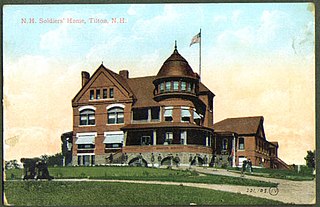
An old soldiers' home is a military veterans' retirement home, nursing home, or hospital, or sometimes an institution for the care of the widows and orphans of a nation's soldiers, sailors, and marines, etc.

Mountain Home National Cemetery is a United States National Cemetery located at Mountain Home, within Johnson City in Washington County, Tennessee. Administered by the United States Department of Veterans Affairs, it encompasses 99.7 acres (40.3 ha), and as of 2018, had over 17,000 interments.

Walter Preston Brownlow was an American politician who represented Tennessee's 1st district in the U.S. House of Representatives from 1897 until his death in 1910. He is remembered for obtaining large federal appropriations for his district, as well as for his intraparty political battles with Chattanoogans Henry Clay Evans and Newell Sanders over control of the state Republican Party. Along with his congressional tenure, Brownlow served as Doorkeeper of the United States House of Representatives from 1881 to 1883, and published the Jonesboro Herald and Tribune from 1876 to 1910.

Togus VA Medical Center is a facility operated by the United States Department of Veterans Affairs in Chelsea, Maine. The facility was built as a resort hotel, and housed Union veterans of the American Civil War prior to being converted to a veterans hospital. It was the first veterans facility developed by the United States government.

The Director's Quarters, Togus Veterans' Administration Center, previously known as the Governor's House, is a historic house on the grounds of the Veterans Administration (VA) facility in Togus, Maine. The house, built in 1869, is historically significant as the only surviving structure of the first National Home for Disabled Volunteer Soldiers, established at Togus in 1866 to serve American Civil War veterans. It was designated a National Historic Landmark in 1974. It is a contributing element of the historic district encompassing the Togus VA campus.

Wadsworth Chapel, also known as the Catholic-Protestant Chapels, is actually two separate chapels under one roof on the campus of the Dept. of Veterans Affairs Medical Center in West Los Angeles, California. The structure was built in 1900 and was closed in 1971 after being damaged in the 1971 Sylmar earthquake. It is the oldest building on Wilshire Boulevard and was listed in the National Register of Historic Places in 1972. The structure has fallen into a state of disrepair due to the lack of funds within the Dept. of Veterans Affairs to pay for the required repairs and renovation.

The Sawtelle Veterans Home was a care home for disabled American veterans in Sawtelle, Los Angeles, California, United States. The Home, formally the Pacific Branch of the National Home for Disabled Volunteer Soldiers, was established in 1887 on 300 acres (1.2 km2) of Rancho San Vicente y Santa Monica lands donated by Senator John P. Jones and Arcadia B. de Baker. The following year, the site grew by an additional 200 acres (0.81 km2); in 1890, 20 acres (0.081 km2) more were appended for use as a veterans' cemetery. With more than 1,000 veterans in residence, a new hospital was erected in 1900. This hospital was replaced in 1927 by the James W. Wadsworth Hospital, now known as the West Los Angeles VA Medical Center.

The National Home for Disabled Volunteer Soldiers, Marion Branch is a historic old soldiers' home located in Marion, Indiana. The hospital, along with Marion National Cemetery were listed on the National Register of Historic Places in 1999 as a national historic district.
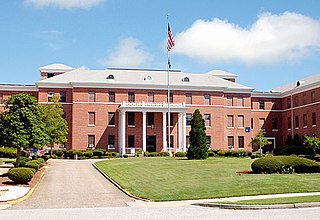
The Tuskegee Veterans Administration Medical Center began in 1923 as an old soldiers' home in Tuskegee, Alabama. It was originally called the Tuskegee Home, part of the National Home for Disabled Volunteer Soldiers system.

The Northwestern Branch, National Home for Disabled Volunteer Soldiers Historic District is a veterans' hospital located in Milwaukee, Wisconsin, with roots going back to the Civil War. Contributing buildings in the district were constructed from 1867 to 1955, and the 90 acres (36 ha) historic district of the Milwaukee Soldiers Home campus lies within the 400 acres (160 ha) Clement J. Zablocki VA Medical Center grounds, just west of American Family Field.

Ward Memorial Hall is an 1880s theater building within the Northwestern Branch, National Home for Disabled Volunteer Soldiers Historic District, located in Milwaukee, Wisconsin. It is part of the Milwaukee Soldiers Home complex, designated Building No. 41, on the present day Clement J. Zablocki VA Medical Center grounds.
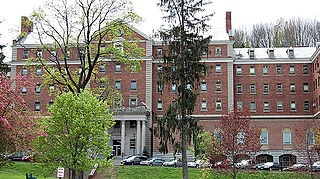
Bath VA Medical Center is a U.S. Veterans Administration hospital located in Bath, Steuben County, New York. Affiliated with the University of Rochester School of Medicine, it provides secondary care and operates clinics in Elmira and Wellsville, New York; and Coudersport and Wellsboro, Pennsylvania. It was added to the National Register of Historic Places in 2013, and designated a national historic district.
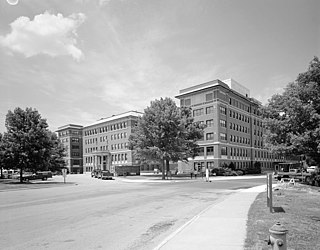
The Western Branch of the National Home for Disabled Soldiers was established in 1885 in Leavenworth, Kansas to house aging veterans of the American Civil War. The 214-acre (87 ha) campus is near Fort Leavenworth, and is directly adjacent to Leavenworth National Cemetery, south of Leavenworth town. The home features about 82 contributing building resources, constructed between the 1880s and the 1940s. It is now part of the Department of Veterans Affairs Eisenhower Medical Center.
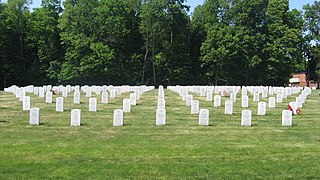
The Danville Branch, National Home for Disabled Volunteer Soldiers Historic District is the historic campus of a branch of the National Home for Disabled Volunteer Soldiers in Danville, Illinois. The branch, which opened in 1898, was one of eleven branches of the National Home, which formed in 1867 to treat Union soldiers disabled during the Civil War. U.S. Representative and Danville resident Joseph Gurney Cannon used his political influence to establish the Danville Branch, which brought money and jobs to the city. The campus served as both a medical facility and a planned community for the area's veterans, and it included housing, veteran-run shops, community halls, a school and library, and a chapel. Most of these buildings were designed in the Georgian Revival style; however, the library is a Classical Revival building, and the chapel has a Gothic Revival design. The campus also includes the Danville National Cemetery. The buildings remaining on the campus are presently divided between Danville's Veterans Affairs hospital and the Danville Area Community College.
Wadsworth was an unincorporated community in Delaware Township, Leavenworth County, Kansas, United States. It is part of the Kansas City metropolitan area.

The Dayton Veterans Affairs Medical Center is located at 4100 West 3rd Street in Dayton, Ohio. Founded in 1867, it is one of the three oldest facilities of what is now the United States Department of Veterans Affairs. When founded, it was known as the Central Branch of the National Home for Disabled Volunteer Soldiers, and it is under this name that a portion of its campus, along with the adjacent Dayton National Cemetery, was designated a National Historic Landmark District in 2012, for its role in the history and management of veterans affairs.
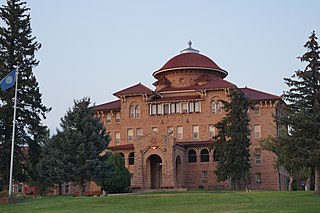
The Battle Mountain Sanitarium was a division of the National Home for Disabled Volunteer Soldiers (NHDVS) located in Hot Springs, South Dakota. Established by law in 1902 and opened in 1907, it was unique among the facilities of the NHDVS, a precursor of today's United States Department of Veterans Affairs (VA), in that it was strictly a medical facility with no residential components beyond its treatment facilities. It was founded to treat former soldiers suffering from musculo-skeletal problems that were believed to be treatable by the region's mineral springs, and for conditions such as tuberculosis whose treatment was improved by the thin dry air. The facilities built for the sanitarium are in an architecturally distinctive Romanesque and Mission Revival style, and now form the centerpiece of the Black Hills Health Care facility, operated by the VA. Most of the complex site was designated a National Historic Landmark in 2011 for its architecture and history.

The Lyons VA Medical Center is a United States Department of Veterans Affairs hospital complex located at 151 Knollcroft Road in the Lyons section of Bernards Township in Somerset County, New Jersey. Established in 1930, it is part of the VA New Jersey Health Care System. Listed as the Lyons Veterans Administration Hospital Historic District, it was added to the National Register of Historic Places on July 3, 2013, for its significance in architecture, health/medicine, and politics/government.





















